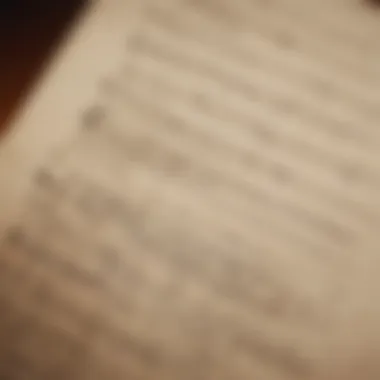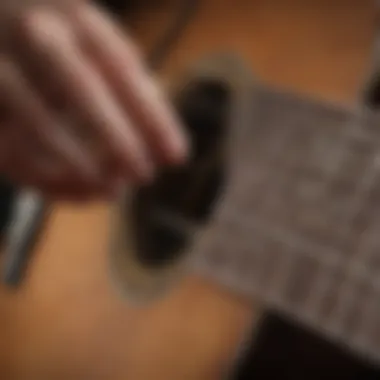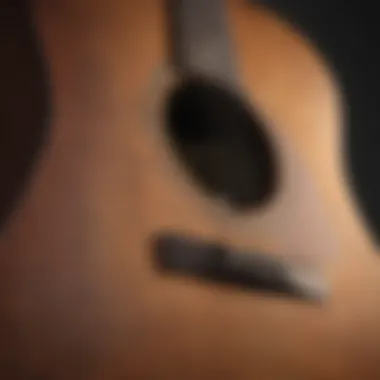Mastering Acoustic Guitar Music: Reading Techniques Explained


Intro
When you pluck the strings of an acoustic guitar, you’re not just producing sound; you’re telling a story, conveying emotions, and connecting with others. Reading acoustic guitar music can seem like stumbling through a dense jungle without a map. Yet, once you grasp the fundamentals, the path becomes clearer. This guide aims to break down the layers of acoustic guitar music, offering insights that will open doors to a deeper understanding and better performance.
Whether you’re a novice, picking up your first instrument, or a seasoned player seeking to refine your skills, understanding musical notation, essential techniques, and how these apply practically is crucial. Music theory, while sometimes daunting, is the backbone of musical expression. In this comprehensive exploration, we’re not only looking at notes and chords but also at the broader landscape of composition and interpretation. So let’s roll up our sleeves and dive into deciphering this beautiful art form.
Understanding Musical Notation
Musical notation serves as the foundation for reading and interpreting acoustic guitar music. It functions like a common language for musicians, allowing them to communicate ideas, emotions, and instructions through symbols rather than mere words. Understanding musical notation is not just a technical skill; it's a vital element that unlocks the treasure chest of music. Through it, aspiring musicians can grasp complex musical concepts that might otherwise take years to master through trial and error alone.
Grasping the essentials of notation enriches your ability as a guitarist. Not only does it facilitate learning new pieces efficiently, but it also helps in understanding the nuances of rhythm, pitch, and dynamics—all crucial to delivering a compelling performance. Whether you aim to join a band, perform solo, or simply enjoy playing at home, a solid grasp of musical notation is indispensable.
The Staff and Its Components
The staff is the backbone of musical notation. It consists of five horizontal lines and the spaces in between, where music notes are placed. Notes written on these lines and in the spaces indicate the pitch of the sounds. The higher up the note is on the staff, the higher the pitch. Conversely, notes lower down correspond to lower pitches.
In conjunction with the staff, various symbols modify the notes' values and behaviors. Some of these components include:
- Ledger lines: Short lines added above or below the staff for notes that extend beyond its limits.
- Bar lines: Vertical lines that divide the staff into measures, helping organize the music.
- Clefs: Symbols at the beginning of the staff indicating which pitches correspond to which lines and spaces.


Each component acts like a piece of a puzzle, coming together to create the picture of the overall score. While it may initially appear daunting, familiarity with the staff will gradually make the reading of music a less intimidating task.
Notes and Rests Explained
Next, let’s talk about notes and rests, which are crucial for conveying rhythm and silence in music. Notes represent sounds, while rests denote moments when no sound is played. Both concepts go hand in hand, creating the rhythm that drives the music.
Notes vary in duration, which is represented by their shape. For instance:
- Whole notes hold for four beats.
- Half notes last for two beats.
- Quarter notes last for one beat, and so on.
Rests have similar values and serve as essential breathers for musicians. Just as you understand when to sound a note, knowing when to rest is equally important. In fact, silence often makes the music more powerful, allowing the noteworthy sounds to resonate.
The Treble Clef and Bass Clef
The clef you choose can fundamentally change how you read music. Here, the treble clef and bass clef serve distinct yet essential roles. The treble clef, often associated with higher register instruments, is used for notes on the staff that are above middle C. This clef dictates that the second line represents the note G, acting like a guiding star for your notes.
Conversely, the bass clef covers lower pitches. It indicates that the second line from the top corresponds to the note F. Familiarizing yourself with these two clefs expands the musical palette available to you, enabling you to perform a broader range of pieces.
"The two clefs together encompass a vast range of sounds that musicians can explore, making them indispensable to understanding musical notation."


Recognizing these clefs and their respective note placements can feel like learning a brand new language at first. Still, it will become second nature over time, greatly enhancing your ability to read music with confidence.
Common Time Signatures
Understanding common time signatures is key for any musician looking to grasp the rhythmical backbone of acoustic music. From folk to jazz, time signatures dictate how music is constructed. They are more than mere numbers; they serve as guidelines on how to interpret and execute rhythm accurately. Learning these common patterns allows musicians to fuse their talents with the ensemble sound, ensuring harmony in collaborative performances.
Understanding Beats and Measures
In its essence, a beat is the smallest unit of time in music. Think of it as the heartbeat that sets the pace. Measures, on the other hand, group beats to provide structure to a piece. For instance, in 4/4 time, which is prevalent in various genres, you have four beats in each measure, with the quarter note getting one beat. This understanding helps in recognizing the flow of the music.
To delve deeper:
- A measure contains a predefined number of beats.
- Each time signature can drastically alter a song's feel.
- Familiarity with beats and measures aids musicians in sight-reading.
Exploring Note Values
Note values further enrich the concept of rhythm. When discussing common time signatures, note values determine how long each note or rest lasts. In 4/4 time, for example:
- A whole note equals four beats.
- A half note equals two beats.
- A quarter note equals one beat.
- Eighth and sixteenth notes are even shorter, creating more complex rhythms.


Mastering note values enables guitarists to add embellishments and variations to their playing. Musicians can express emotions and styles simply by manipulating these values.
"Understanding note values allows a musician to breathe life into the notes, transforming written music into emotional performance."
Diverse Time Signatures in Acoustic Music
While 4/4 remains a staple, acoustic music embraces a spectrum of time signatures. For example, 3/4, often referred to as waltz time, can evoke a graceful sway. In contrast, 6/8 can create a lively, driving feel, commonly found in folk and traditional tunes.
Different time signatures introduce unique challenges and expanses of creativity. Here’s what you might encounter:
- 5/4: Used in progressive rock and jazz, offering an irregular yet captivating rhythm.
- 7/8: Often heard in Eastern European music, characterized by its off-balance feel.
- 12/8: Gives a bluesy swing, allowing for more flow beneath the notes.
Understanding these various time signatures enhances one’s versatility and adaptability, whether strumming alone or jamming with others.
Reading Chord Diagrams
Understanding how to read chord diagrams is fundamental for any acoustic guitar player. It’s like having a roadmap that guides you through the intricate landscape of strings and frets. For beginners and experienced players alike, chord diagrams simplify the learning process, allowing musicians to visually grasp how to form different chords without the need for complex sheet music.
Chord diagrams can save you time in figuring out finger placements. They can also enhance your exploratory skills, letting you experiment with various sounds quickly. Here’s a more detailed look at chord diagrams.
What is a Chord Diagram?
A chord diagram is simply a visual representation of a chord. Think of it as a snapshot of where to place your fingers on the fretboard. Chord diagrams are often presented as grids that resemble the neck of a guitar. Horizontal lines represent the frets, while vertical lines represent the strings. An 'X' at the top of a diagram indicates that the string should not be played, while an 'O' suggests it should ring open, without any fingers pressing down on it. In some cases, numbers are shown on the diagram as well, indicating which fingers to use.
Here’s a simplified version of a chord diagram for a basic G major chord:







